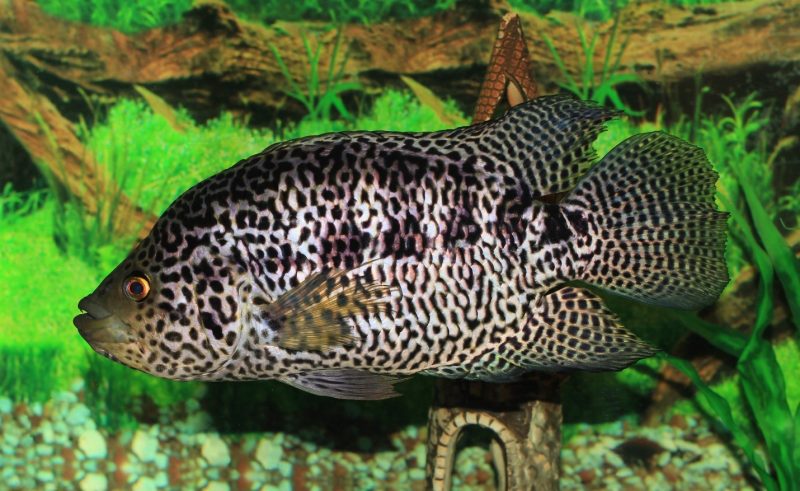Adding new fish to your aquarium can be tricky, especially when you want to liven things up with a unique species. The hardest ones to cater to are by far the predators, as they find it hard to get along with less aggressive beings. Such is the case of the Jaguar cichlid, a medium-sized beauty that can get rather feisty when prey appears on its radar.
If adding one to your tank appeals to you, then you need to be aware of the peculiarities of the Jaguar cichlid. This species is as beautiful as it is demanding, especially when it comes to feeding time. What is more, it doesn’t play well with everyone, which means that paying attention to pairings is essential. Here is what you should know on the topic to create the perfect balance.
About the Jaguar Cichlid
Scientifically known as Parachromis managuensis or the Cichlasoma managuense, the Jaguar cichlid is a Central American species of freshwater fish. Its swimming grounds spread from Honduras to Costa Rica, and it is a fish both consumed for food and held in aquariums as a pet. Its edibility is described as being excellent, as it is a mainstay dish in its indigenous area.
While females measure around 30 centimeters in size, or roughly 12 inches, males grow as large as 35 centimeters, or 14 inches. However, the average size of one specimen is of 22 centimeters. The species goes by many names, such as Aztec cichlid, managuense cichlid, Managua cichlid, spotted guapote, guapote Tigre, and jaguar guapote.
Their appearance is similar to that of black basses and sunfish, but their distinguishing trait is the existence of a single nostril on each lateral of the head. It also has a discontinuous lateral line separated in two parts. Its body is sprinkled with quite a few purplish-black spots, which give it the jaguar-like appearance suggested in its name.
This unique and interesting look is what makes the jaguar cichlid more than just a delicious tropical meal. It is a beautiful companion that can liven up the atmosphere in any fish tank. However, due to its nature, it also requires special care. If you want to add it to your aquarium, you should consider a few things first.
Caring for This Species

The Jaguar cichlid is now widely found in South Floridian canals, as it can easily adjust to a habitat of lakes with a rocky, sandy, or muddy bottom. This makes the species quite tolerant to poor water quality. Nevertheless, this doesn’t imply that you should skip out on cleaning the tank regularly. It still needs attention and care, just like any other living being.
What you need to consider above else are its feeding habits. The Jaguar cichlid is a medium sized raptorial and opportunistic predator that consumes small snails, aquatic insects, snails, and even lizards from time to time. Therefore, it doesn’t play well with defenseless tank mates. Instead, you need to pair with other predators of a similar aggression level.
In fact, it coexists best with other cichlid species that are territorial and aggressive just like it. Optimum tank mates are thus the Jack Dempsey cichlid, the Midas cichlid, and the Texas cichlid. Other varieties tend to be a bit more defensive, which can be detrimental for the miniature marine ecosystem you are trying to build.
Come feeding time, one mature jaguar cichlid can consume as many as 10 swordtails. You should only feed it once a day and try to vary its menu from time to time. It will also greatly enjoy worms, tadpoles, or crickets. As long as it is alive and moving, your cichlid will devour it right away. Cut up fish and crayfish works too, but not too often.
Dried fish food is also beneficial for their development and health. Avoid feeding the jaguar cichlids pieces of beef, pork, or poultry, as they are not equipped to digest this type of meat. What is more, allowing them to fast for one day a week is recommended, as it boosts their appetite and cleanses their system.
Finally, keep in mind that while jaguar cichlids prefer tepid waters, their aggression levels rise with the temperature. For this reason, you should keep the tank at around 77 degrees Fahrenheit, or 25 degrees Celsius. This will keep them calm enough to play well with others, but not numb them down completely either. It is the perfect situation for them.
The Bottom Line
Adding a predatory fish to your tank is never easy, and this is true in the case of the Jaguar cichlid as well. However, by feeding it right and paying extra attention to water temperature, you will certainly provide the little guy with a pleasant environment where it can thrive. Just be careful not to throw other defenseless aquatic beings in the mix, or you will regret it.



